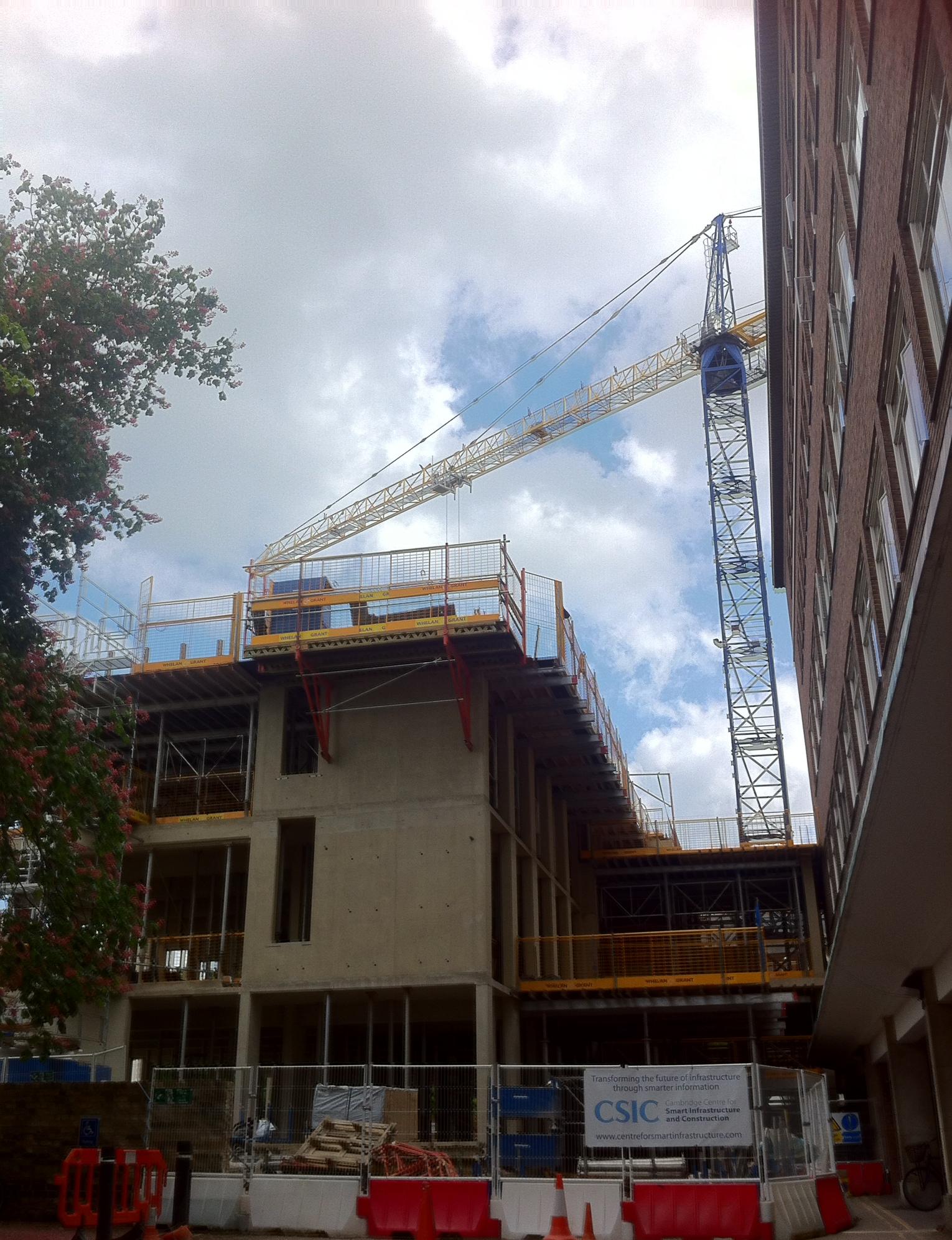
Submitted by Administrator on Fri, 22/05/2015 - 15:46
The Department of Engineering’s new James Dyson Building is taking shape. During the past six months, CSIC engineers have been instrumenting specific parts of the structure to create a hi-tech ‘living lab’.
Currently standing three storeys high, the finished four-storey structure, due to complete in November this year, will house postgraduates and support pioneering research in areas including smart infrastructure. CSIC will continue to instrument the building throughout the construction process and data will be accessible throughout the entire design life of the James Dyson Building.
CSIC is working alongside contractors Morgan Sindall and Whelan & Grant to integrate a variety of novel technologies in the fabric of the building to bring the structure to life.
“The James Dyson Building will showcase a variety of CSIC tools and technologies to create a structural ‘nervous system’. The building itself will be an exciting learning tool,” said Dr Pasquale Ponterosso, Project Manager of the CSIC deployments on the James Dyson Building. “These technologies will be operational throughout the whole life of the asset, enabling us to build a significant database monitoring the behaviour of the building over many years.”
“Our instrumentation creates a living classroom where students can learn about, for example, load and strain, by looking at the behaviour of an actual structure rather than a blackboard. This enables a more hands-on approach to teaching and learning,” said Dr Nicky de Battista, Research Associate at CSIC, who is leading the instrumentation of the building.
Distributed fibre optic strain sensors and fibre Bragg sensors have been embedded within a section of the building’s reinforced concrete frame, including columns, beams and slabs. The sensors can be interrogated at any time to measure the strain profile within that part of the building, and how the load is being transferred through the different structural elements down to the foundation. Researchers and students will be able to observe, for example, how different loading configurations on a floor affect the shear, axial and bending strain within the structure.
Data gathered from the building will be displayed and linked to an IT hub on the ground floor. Interested parties, including students, scholars, industry professionals and school children will be invited to tour the building to experience the ‘living lab’ and learn directly from this innovative building.
CSIC instrumentation includes:
• distributed fibre optic sensors (DFOS) embedded in a number of foundation piles to provide data including temperature gradient of the piles, temperature of the concrete as it is setting and strain within the pile as the load upon it changes
• DFOS embedded in three four-storey columns to measure temperature and axial strain
• DFOS embedded in a two-span continuous beam on the second floor of the building to measure temperature, shear strain and bending strain; and fibre Bragg grating sensors, embedded in the same beam at one-metre intervals, to measure temperature and dynamic bending strain
• Aadense array of DFOS embedded in two layers within a continuous one-way spanning slab, using approximately 600m of fibre optic cable, to measure temperature and bending strain
• detailed zone-by-zone sub-metering of heating, cooling, and power consumption, coupled with occupant movement through radio-frequency identification (RFID) to develop new modelling tools better aligned to represent when and where a building consumes energy.
• Evaluation of technology choices for supplying heating, cooling and ventilation to the building at pre-design, post-construction, and post-occupancy stages
• 3D-laser scanning to create a record of the as-built structure of the building. This provides a useful learning tool for an industry currently implementing Building Information Modelling (BIM) as part of a four-year government strategy requiring collaborative 3D-project and asset information, documentation and data to be in electronic format by 2016
• a power-efficient, digital signal processor (DSP)-based wireless sensor network (WSN) noise-monitoring system, currently in development, deployed around the site boundary to measure vibration, noise and impact. Additional testing methods, including a wired noise sensor and sound camera, will gather further data from the James Dyson Building to enhance the development of the noise-recognition algorithm. This tool may have future use in monitoring and minimising construction noise disruptions on building sites
Instrumenting the building has presented challenges as well as valuable live-site experience. “The CSIC team can take what we have learned from working here to other deployments,” said Dr de Battista. “It has also provided an opportunity to test different techniques; we trialled a fixing system of rubber tubes and cable ties for the fibre optic cable, which was more cost effective than traditional clamps, and we are now deploying this system elsewhere on other projects.”
CSIC’s key aim is to deliver novel technologies, emerging from leading research at the University of Cambridge, to innovate the construction and infrastructure industries. The level of instrumentation of this building is ground-breaking and the technologies deployed here may be developed to become industry standards for the future.
“This is the first time we have instrumented a slab, beam or column in this way. It is also the first time CSIC has instrumented a reinforced concrete-framed building as densely as this,”said Dr de Battista. “The data that will be readily available from this instrumentation will provide, with unprecedented detail, an insight into how a relatively ordinary structure reacts to the daily loading cycles imposed on it, and how the behaviour of the structure changes as it ages over the decades.“
“By heavily instrumenting the James Dyson Building we are able to increase our knowledge of the way buildings really behave during and after construction,” said Dr Ponterosso. “It is also an opportunity for CSIC to gather data in order to help validate current design principles with a view to making more sustainable efficiencies in the design and construction of future infrastructure, as well as providing industry with more confidence and iterating solutions.”
Editor’s note: The James Dyson Foundation, will provide a state-of-the-art facility to support world-leading research and teaching at the University of Cambridge.
